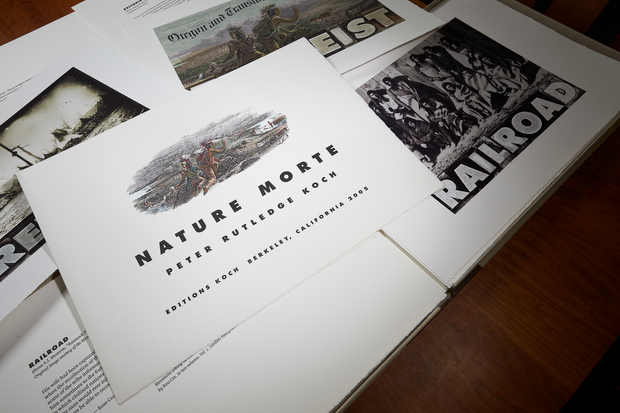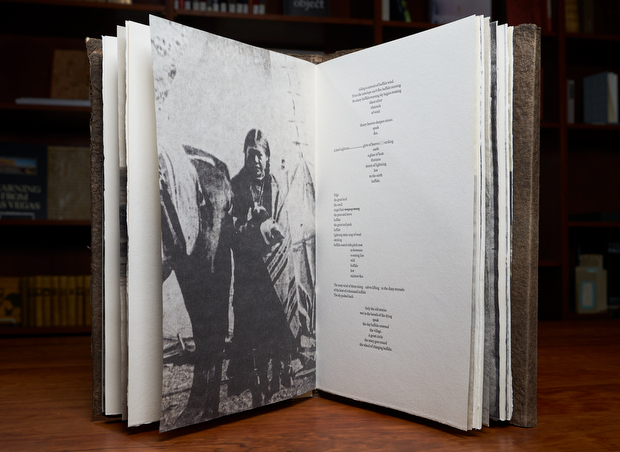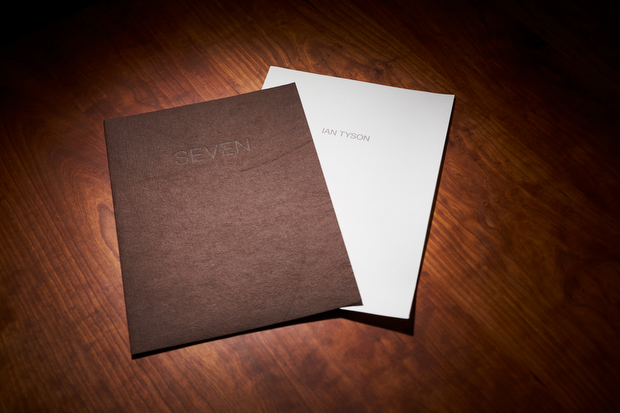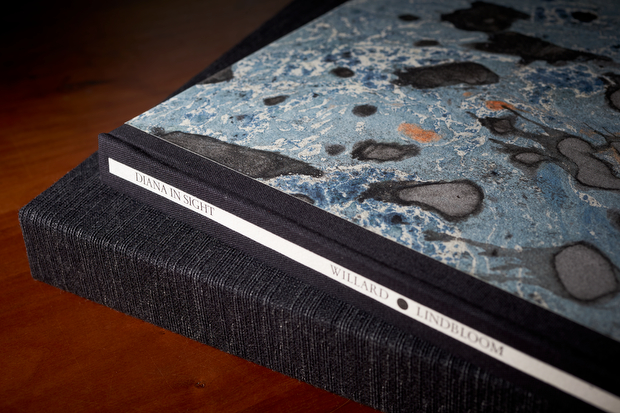
Curator Peter Michel reflects on the collection of Artists' Books held in UNLV Special Collections and Archives. Photography by Aaron Mayes, Curator of Visual Materials.
The book as an object designed for the transmission of text persists as a significant artifact even in a culture increasingly digital. Not all books are created as works of art, but those that are have been collected by connoisseurs, bibliophiles, and Special Collections librarians for as long as there have been libraries. Book art is a collaborative art form created by artists in small but thriving studios and printing shops. Artists, poets, writers, printmakers, engravers, papermakers, bookbinders, photographers, together create an artist’s book, in which text and illustration are fused within the tactile structure of paper, binding and case. UNLV Special Collections & Archives has a small collection of artists’ books representing local and regional artists, authors, and presses, a few of which we would like to highlight here.
Peter Koch, typographer, designer, printer, and author has an international reputation in fine press printing and a catalogue of oeuvre dating from 1974. Koch’s longstanding interest in the changing face of his native Montana and the American West has resulted, in his words, in “an ongoing series of literary explorations utilizing appropriated photographs as evidence and documenting man’s battle against nature in the American West.” The volumes include Hard Words I and II, Nature Morte, The Lost Journals of Sacajewea and the latest volume, Liber Ignis. After a visit by Peter Koch to UNLV Special Collections & Archives we started to acquire his western-themed works that seem a reflection on the history of Nevada.
Nature Morte, Berkeley, California: Editions Koch, 2005
A portfolio of digital pigment prints assembled from historic photographs and documents; text from the manuscript journals and papers of Meriwether Lewis, William Clark, Elers Koch and others; and short legends by the artist hand-set in lead type. A preface by Rick Newby, an introduction by Griff Williams, and a statement by the artist complete the portfolio.
Nature Morte was originally commissioned in exhibition print format by the Holter Museum in Helena, Montana on the occasion of the bicentennial of the Lewis and Clark expedition 1804-1805.

The Lost Journals of Sacajewea, Debra Magpie Earling; illustrated by Peter Rutledge Koch.Berkeley, CA: Editions Koch, 2010
The Lost Journals of Sacajewea began as a project during the bicentennial of the Lewis and Clark expedition. In the Spring of 2005, the Missoula Museum of Art had two exhibitions running simultaneously that were critical responses to the celebratory afflatus that customarily surrounds such events. There Koch saw a fragment of a poem that accompanied Native Perspectives on the Trail: A Contemporary American Indian Portfolio written by Debra Magpie Earling, a member of the Confederated Salish and Kootenai Tribes of the Flathead Reservation, and an award-winning novelist and poet. Based on that fragment, Koch proposed a collaboration.
The text is printed on hand-made paper at Peter Koch Printers and bound at the press by Jonathan Gerken. The smoked buffalo rawhide cover paper was designed and hand-made by Amanda Degener especially for this edition at Cave Papers in Minneapolis, Minnesota. The spine is beaded with trade beads and small caliber cartridge cases.

Liber Ignis, Peter Rutledge Koch, Adam Cornford, and Jonathan Gerken. Berkeley, California: Editions Koch, 2015
Liber Ignis is a collaborative project of appropriations, inventions, and constructs documenting the ongoing war against nature in the American West. A collage poem composed in counterpoint to the images by Adam Cornford, image manipulation, surface engineering, & binding structure by Jonathan Gerken.
Koch was inspired by a visit to a small gallery in Germany, “saturated,” as he described it, “with the leaden-grey ashes of war and suffering.” “Pursuing my work in the archives of mining and banking – appropriating images and building my own memorials,” Koch created this stark vision of a dark industrial landscape which mining had wrought in Montana. LIBER IGNIS consists of six lead sheets printed on a UV cured acrylic flatbed press interleaved with laminated felt and split microfiber sheets dyed black and printed from polymer plates at Peter Koch Printers. The binding is constructed with soldered copper tubing and linen thread.
Michelle Burgess, the director of Brighton Press of San Diego visited UNLV Special Collections & Archives last May. Burgess works in printmaking, painting, sculpture, and book art. With Bill Kelly, the founder of the Brighton Press, she has produced forty-six limited edition artist books and broadsides, often working with contemporary poets and artists. The artists make their own plates and cut their own blocks. Each work is printed by hand in their studio in small editions and is signed and numbered.
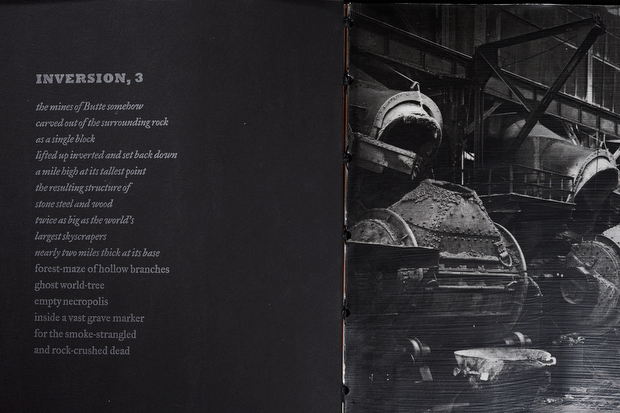

Diana in Sight, Poems by Nancy Willard; archivally hand printed Diana photographs by Eric Lindbloom. printed on Twinrocker “Turner Blue” handmade paper. Case bound in Japanese cloth and hand marbled paper and housed in a clamshell box. Edition of 30. 2009.
In 1978-79, poet Nancy Willard and artist Eric Lindbloom traveled together with their young son through the northeastern U.S. while Willard was on various poetry reading tours. They then went to Italy and Holland. Lindbloom made these photographs in small, largely unnoticed places along the way. According to him: “These photographs were all about the joy of using the lighthearted Diana, a toy camera, after a long apprenticeship with a 4’ x 5’ stand camera, with its physical and historical weight on my back. They were part of a series called ‘Private Lives of Public Places.’” Willard wrote the poems twenty years later in 1998.

SEVEN motes of zen dust. Japanese koans with text and woodcuts by Ian Tyson. Printed on Twinrocker and Cave papers. Housed in embossed slipcase covered in cross-dyed linen. Edition of 40. 2015.
Ian Tyson’s Seven motes of zen dust, represents his dialogue, in words and images, with seven Zen Buddhist koans. A koan is a Japanese riddle or paradox in the Buddhist tradition that is meant to be contemplated until the end of time. Tyson writes, “Using more or less consistent phrases, I have added personal commentary that may seem at variance with the koan. My intention is to intensify the original by opposing it with an alternative reference. The printing of the ‘core’ koan text and blocks in black on handmade paper with the ‘commentary’ text and blocks printed in color on a translucent Twinrocker paper—which is overlaid on it—emphasizes the two aspects of the extracts.”

Thirty-six chapter numbers designed by the artist. Bound in printed cloth over boards with a wraparound image, hand painted by the artist. Number 71 of edition of 94. 1988.
This short story was first published in 1936 in the literary journal Transition and was later collected into Adventures in the Skin Trade published by New Directions. "The Mouse and the Woman" is a cyclical tale whose dreamlike narrative approaches the boundaries of surrealism.
Photography by Aaron Mayes


